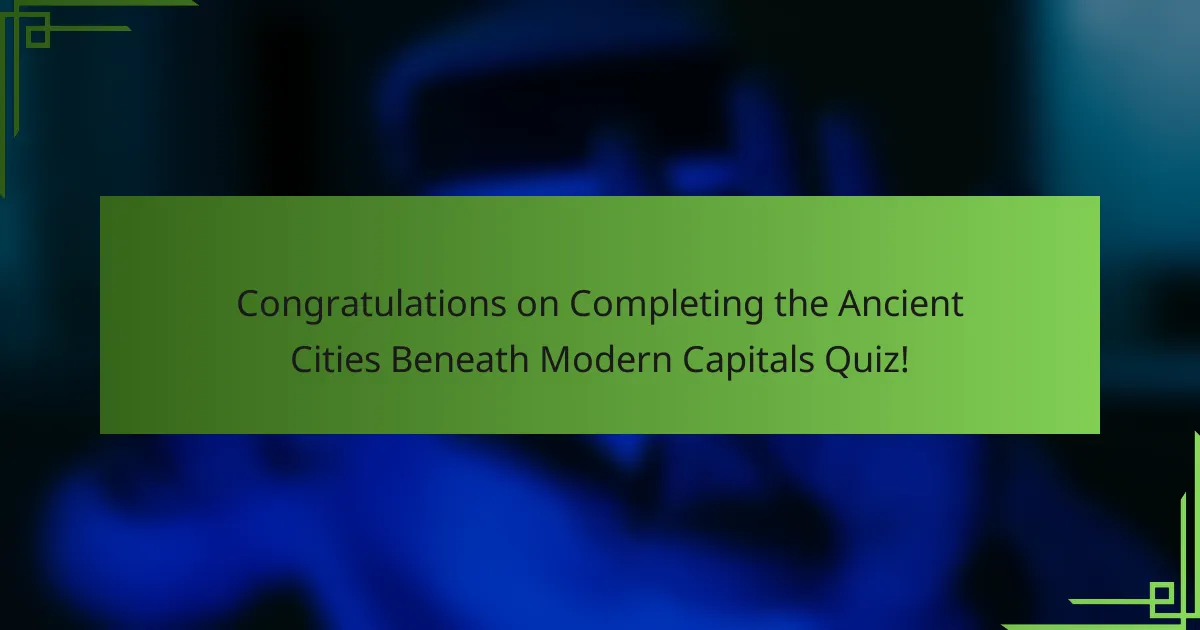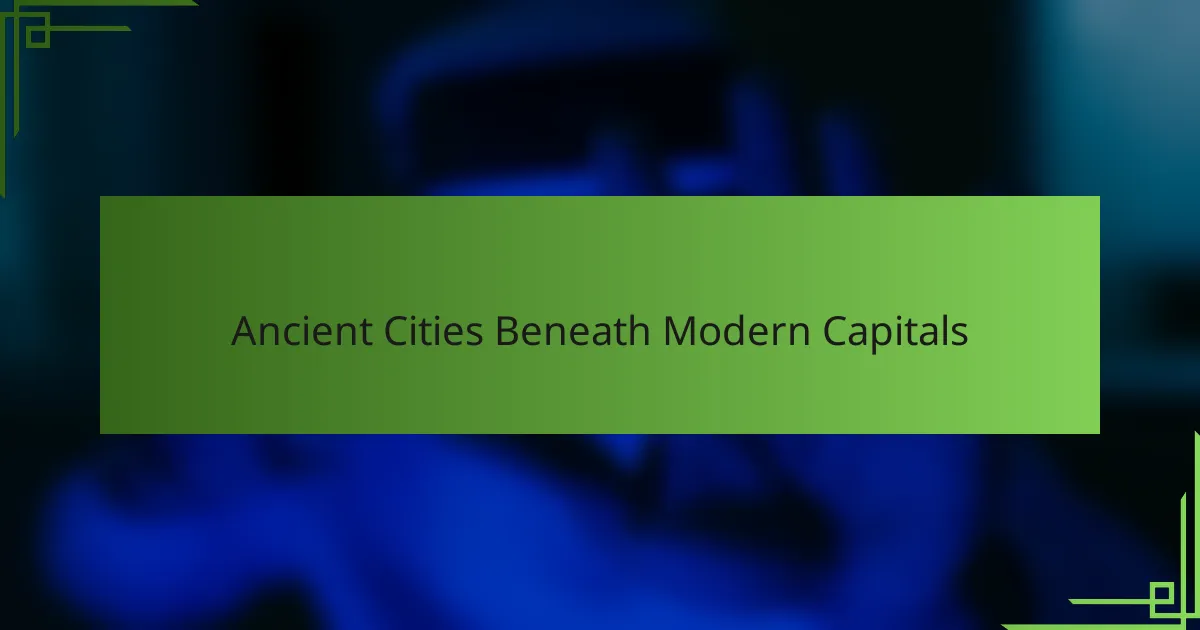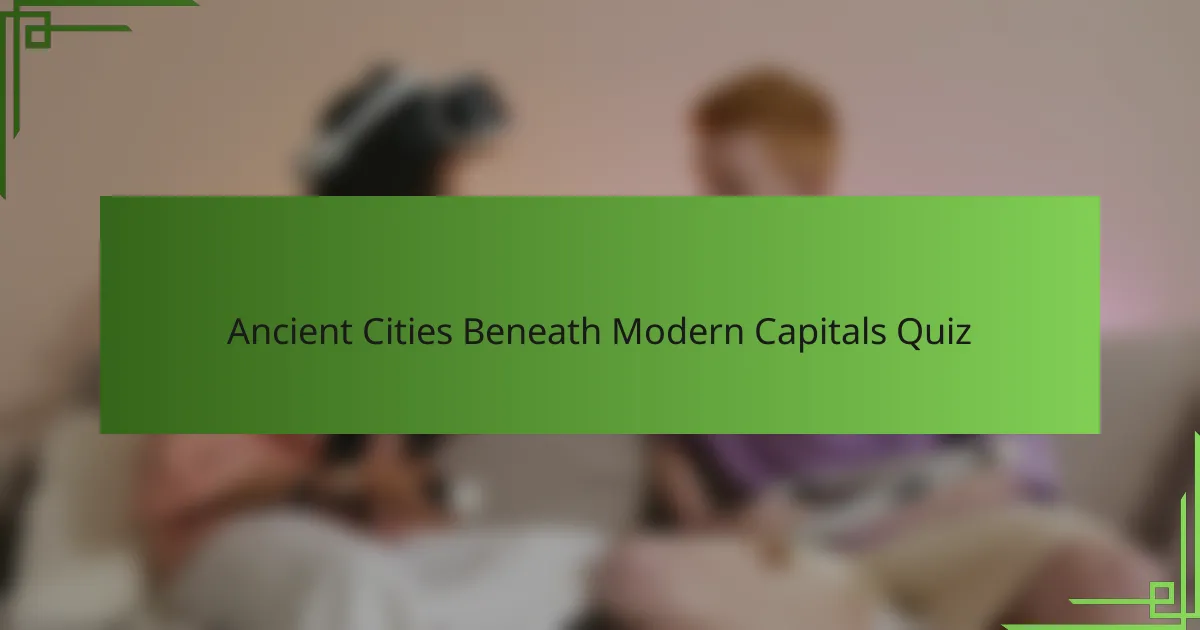
Ancient Cities Beneath Modern Capitals Quiz
1. Which ancient city lies beneath the modern capital of Mexico City?
- Tenochtitlan
- Cholula
- Teotihuacan
- Tula
2. What is the name of the ancient city located beneath present-day Rome, Italy?
- Herculaneum
- Pompeii
- Tivoli
- Ostia Antica
3. Beneath which modern capital city can you find the ancient city of Tenochtitlan?
- Mexico City
- Buenos Aires
- Lima
- Bogotá
4. Which ancient city ruins are found under modern Istanbul, Turkey?
- Ephesus
- Troy
- Byzantium
- Pergamon
5. What ancient Egyptian city is located beneath modern Cairo?
- Thebes
- Memphis
- Heliopolis
- Abydos
6. Beneath which modern capital city lies the ancient city of Byzantium?
- Istanbul
- Rome
- Athens
- Alexandria
7. Which ancient Mesopotamian city is found under modern Baghdad?
- Nippur
- Kish
- Babylon
- Uruk
8. What is the name of the ancient city beneath modern Athens, Greece?
- Acropolis
- Agora
- Piraeus
- Kerameikos
9. Beneath which modern capital can you explore the ancient city of Uruk?
- Amman
- Damascus
- Baghdad
- Tehran
10. Which ancient city lies beneath the streets of modern Paris, France?
- Lutetia
- Lugdunum
- Massalia
- Alesia
11. What ancient city is located beneath Mexico City`s Zócalo square?
- Tenochtitlan
- Teotihuacan
- Tulum
- Palenque
12. Beneath which Asian capital city can you find the ancient city of Lothal?
- Islamabad
- Kathmandu
- Dhaka
- New Delhi
13. Which ancient city exists beneath the modern capital of Kathmandu, Nepal?
- Kantipur
- Banepa
- Lalitpur
- Bhaktapur
14. What is the ancient city that lies beneath the modern city of Jerusalem?
- Jericho
- Hazor
- Megiddo
- City of David
15. Beneath which modern capital city are the ruins of the ancient city of Carthage found?
- Algiers
- Tripoli
- Tunis
- Rabat

Congratulations on Completing the Ancient Cities Beneath Modern Capitals Quiz!
You’ve reached the end of this fascinating quiz exploring ancient cities hidden beneath today’s bustling capitals. Throughout this quiz, you have uncovered how geography shapes human history and the layers of civilization beneath our feet. Each question offered a glimpse into the remarkable stories cities carry from their ancient pasts to their modern forms.
By engaging with these questions, you likely learned about how natural landscapes influenced urban development and the ways old and new coexist in these metropolises. Understanding these connections enhances our appreciation of geography’s role in shaping human settlements over millennia. It also highlights the importance of archaeological insights in revealing what lies beneath the surface of contemporary life.
We invite you to continue your journey by exploring the next section on this page dedicated to Ancient Cities Beneath Modern Capitals. There, you will find detailed information and maps that deepen your understanding of these remarkable urban layers. Dive in to expand your geographical knowledge and discover even more about the hidden worlds beneath the capitals you thought you knew so well.

Ancient Cities Beneath Modern Capitals
Definition and Significance of Ancient Cities Beneath Modern Capitals
Ancient cities beneath modern capitals refer to archaeological sites and remnants of earlier urban settlements located directly under current capital cities. These subterranean ruins provide valuable insights into historical urban development, cultural continuity, and geographical transformations over centuries. The study of such cities highlights how contemporary capitals like Rome, Mexico City, and Cairo are built atop layers of past civilizations, revealing the dynamic nature of human settlement and city evolution in geography.
Geographical Distribution of Subterranean Ancient Cities in Capital Cities
Ancient cities beneath modern capitals are found on multiple continents, primarily in regions with long histories of urbanization. Examples include the ancient Roman city of Aurelianum under modern Rome, Tenochtitlan beneath Mexico City, and the city of Memphis beneath modern Cairo. These locations represent strategic geographical points such as river valleys, coastlines, and trade routes that attracted early human settlement. The underlying geology and stable landforms often supported multi-layered urban occupation, which geography studies to understand human-environment interaction over time.
Ancient Rome Beneath the Modern City of Rome
Modern Rome is built on top of the ancient Roman city, which was centered around the Roman Forum, Palatine Hill, and the Colosseum area. The ruins of ancient Rome include remnants of temples, roads, and aqueducts beneath present-day streets. These layers illustrate the city’s continuous occupation from antiquity to present, reflecting geographical features such as the Tiber River’s influence on urban layout. Archaeological excavations and mapping techniques document the ancient city’s spatial organization, significantly contributing to urban geography and historical studies.
Tenochtitlan Under Mexico City: Geographic and Historical Layers
Mexico City is situated above the Aztec capital Tenochtitlan, originally built on an island in Lake Texcoco. The geographical setting of a lake basin led to the unique construction of chinampas (floating gardens) and causeways that defined urban planning. The drainage of Lake Texcoco and urban expansion caused ecological and geographical changes now studied for their impact on city sustainability. Excavations reveal the Aztec city’s religious and political structures beneath the modern metropolis, merging geography with archaeology and history.
Memphis Beneath Modern Cairo: A Geographical Perspective
The ancient city of Memphis, once the capital of Old Kingdom Egypt, lies beneath the modern urban sprawl of Cairo. Located near the banks of the Nile River, Memphis was strategically placed for trade and agriculture. Over time, Cairo expanded onto this fertile floodplain, covering the ruins of temples, palaces, and necropolises. The Nile’s geographical influence on settlement patterns is critical to understanding the layering of ancient Memphis beneath Cairo, which geographic information systems and satellite surveys continue to analyze for heritage preservation and urban planning.
What are ancient cities beneath modern capitals?
Ancient cities beneath modern capitals refer to archaeological sites and historical urban settlements that exist underground or below the current surface level of present-day capital cities. These ancient cities were often the original foundations or earlier phases of urban development, later built over by newer cities. For example, beneath Mexico City lies the Aztec city of Tenochtitlan, preserved under the modern metropolis.
How do archaeologists discover ancient cities beneath modern capitals?
Archaeologists discover these cities through excavation, ground-penetrating radar, remote sensing technology, and historical records. For instance, in Rome, Italy, underground ruins of the Roman Forum and ancient buildings have been uncovered by systematic digs and surveys. Combining these methods allows experts to locate and study buried urban layers within current capitals.
Where are some significant ancient cities located beneath modern capitals?
Significant examples include Tenochtitlan beneath Mexico City in Mexico, Londinium beneath London in the United Kingdom, and Canopus beneath Alexandria in Egypt. Each of these ancient cities played crucial roles in their historical eras and remains accessible or partially studied beneath the modern capitals.
When were these ancient cities commonly built beneath what are now modern capitals?
These ancient cities date back several centuries to millennia before the establishment of modern capitals, often from periods ranging from around 500 BCE to the early medieval era. For example, Tenochtitlan was founded in 1325 CE before modern Mexico City was established, and Londinium was founded by the Romans around 43 CE beneath present-day London.
Who were the original inhabitants of these ancient cities beneath modern capitals?
The original inhabitants were the civilizations that founded these cities. For instance, the Aztecs inhabited Tenochtitlan beneath Mexico City, the Romans founded Londinium beneath London, and the ancient Egyptians established Canopus beneath Alexandria. These groups built the initial urban centers later overlaid by contemporary cities.
